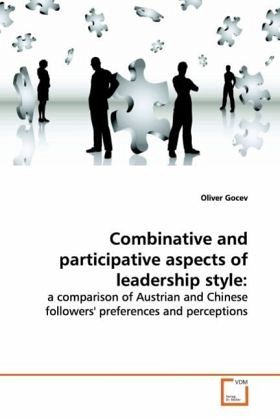
Combinative and participative aspects of leadership style:
a comparison of Austrian and Chinese followers' preferences and perceptions
Versandkostenfrei!
Versandfertig in 6-10 Tagen
39,99 €
inkl. MwSt.

PAYBACK Punkte
20 °P sammeln!
In the course of globalization and FDI multinationalshave to consider the specific cultural impacts onmanagement. Employee behaviors and values differacross cultures. Cultural differences call fordifferences in management practices to ensurefinancial performance and growth. In view of China and Austria, the first researchquestion which this paper will try to answer is: Which participative leadership style is preferredand perceived in the two cultures?Although most cultures consider leaders who providetask-related and socio-emotional activities aseffective, distinctions remain due toculture-spe...
In the course of globalization and FDI multinationals
have to consider the specific cultural impacts on
management. Employee behaviors and values differ
across cultures. Cultural differences call for
differences in management practices to ensure
financial performance and growth.
In view of China and Austria, the first research
question which this paper will try to answer is: Which participative leadership style is preferred
and perceived in the two cultures?
Although most cultures consider leaders who provide
task-related and socio-emotional activities as
effective, distinctions remain due to
culture-specific perception differences when varying
the combinations of these two leadership functions in
order or temporality. Casimir & Li (2005) associated
the differences mainly to PD. As to the close
connection of PD with participative management on the
one hand and with combinative leadership on the other
hand, the following questions are stated: Which combinative leadership style is preferred in
Austria and China? Is there a coherent preference for combinative
leadership styles among Austrian and Chinese
employees who prefer or perceive the same
participative leadership style?
have to consider the specific cultural impacts on
management. Employee behaviors and values differ
across cultures. Cultural differences call for
differences in management practices to ensure
financial performance and growth.
In view of China and Austria, the first research
question which this paper will try to answer is: Which participative leadership style is preferred
and perceived in the two cultures?
Although most cultures consider leaders who provide
task-related and socio-emotional activities as
effective, distinctions remain due to
culture-specific perception differences when varying
the combinations of these two leadership functions in
order or temporality. Casimir & Li (2005) associated
the differences mainly to PD. As to the close
connection of PD with participative management on the
one hand and with combinative leadership on the other
hand, the following questions are stated: Which combinative leadership style is preferred in
Austria and China? Is there a coherent preference for combinative
leadership styles among Austrian and Chinese
employees who prefer or perceive the same
participative leadership style?












